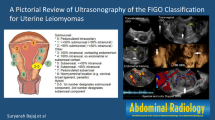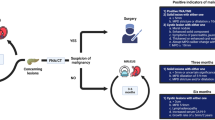PURPOSE
The behavior of intra-abdominal desmoids in familial adenomatous polyposis is incompletely understood. Findings range from typical mass lesions to flat sheets, termed the desmoid reaction or desmoid precursor lesion. The latter often are incidental findings of uncertain significance. The study was designed to describe the natural history of incidental intra-abdominal desmoid tumors with particular reference to the desmoid reaction.
METHODS
Patients who underwent laparotomy for familial adenomatous polyposis at the Cleveland Clinic Foundation were identified. The incidence of incidental intra-abdominal desmoid tumors was determined by review of operative records. Intra-abdominal desmoid tumors were classified as mass lesions if three-dimensional or desmoid reaction if two-dimensional. The incidence of clinically apparent intra-abdominal desmoid tumors (typical mass lesions on physical examination or cross-sectional imaging in symptomatic patients) was determined by chart review. The incidence of clinical intra-abdominal desmoid tumors between groups was compared by Fisher’s exact test.
RESULTS
A total of 266 patients (153 females; median age, 26 (range, 9–63) years) underwent abdominal surgery for familial adenomatous polyposis. Incidental intra-abdominal desmoid tumors were identified in 34 patients: 8 at the index surgery and 26 at relaparotomy. These lesions influenced the planned procedure in eight cases (26 percent), including preventing ileoanal pouch in 3 of 19 patients in whom this was intended. The median follow-up from the time of identification of intra-abdominal desmoids was 42 (range, 2–178) months at which point four patients (11 percent) had developed clinical intra-abdominal desmoid tumors. There was no significant difference in incidence of clinical intra-abdominal desmoid tumors between mass and desmoid reaction groups (P = 0.27).
CONCLUSIONS
Incidental intra-abdominal desmoid tumors are a common finding at relaparotomy in patients with familial adenomatous polyposis. These lesions influence planned surgery in a minority of cases. Desmoid reaction may have little bearing on the subsequent development of clinically significant intra-abdominal desmoid tumors.

Similar content being viewed by others
REFERENCES
To the article
T Anthony MA Rodriguez-Bigas T Weber NJ Petrelli (1996) ArticleTitleDesmoid tumors J Am Coll Surg 182 369–77
JJ Reitamo TM Scheinin P Hayry (1986) ArticleTitleThe desmoid syndrome. New aspects in the cause, pathogenesis and treatment of desmoid tumor Am J Surg 151 230–7
IT Jones VW Fazio FL Weakley DG Jagelman IC Lavery E McGannon (1986) ArticleTitleDesmoid tumours in familial polyposis coli Ann Surg 204 94–7
AM Lotfi RR Dozois H Gordon et al. (1989) ArticleTitleMesenteric fibromatosis complicating familial adenomatous polyposis: predisposing factors and results of treatment Int J Colorectal Dis 4 30–6
C Penna A Kartheuser R Parc et al. (1993) ArticleTitleSecondary proctectomy and ileal pouch-anal anastomosis after ileorectal anastomosis for familial adenomatous polyposis Br J Surg 80 1621–3
AK Gurbuz FM Giardello GM Peterson et al. (1994) ArticleTitleDesmoid tumours in familial adenomatous polyposis Gut 35 377–81
MA Rodriguez-Bigas MC Mahoney CP Karakousis NJ Petrelli (1994) ArticleTitleDesmoid tumors in patients with familial adenomatous polyposis Cancer 74 1270–4
L Heiskanen HJ Jarvinen (1996) ArticleTitleOccurrence of desmoid tumours in familial polyposis and results of treatment Int J Colorect Dis 11 157–62
SK Clark KF Neale JC Landgrebe RK Phillips (1999) ArticleTitleDesmoid tumours complicating familial adenomatous polyposis Br J Surg 86 1185–9
R Caspari S Olschwang W Friedl et al. (1995) ArticleTitleFamilial adenomatous polyposis: desmoid tumours and lack of ophthalmic lesions (CHRPE) associated with APC mutations beyond codon 1444 Hum Mol Genet 4 337–40
DM Eccles R Lujit ParticleVan der C Breukel et al. (1996) ArticleTitleHereditary desmoid disease due to a frameshift mutation at codon 1924 of the APC gene Am J Hum Genet 59 1193–201
RJ Scott NJ Froggatt RC Trembath DG Evans SV Hodgson ER Maher (1996) ArticleTitleFamilial infiltrative fibromatosis (desmoid tumours) (MIM 135290) caused by a recurrent 3′ APC gene mutation Hum Mol Genet 5 1921–4
ML Arvanitis DG Jagelman VW Fazio IC Lavery E McGannon (1990) ArticleTitleMortality in patients with familial polyposis Diseases Colon Rectum 33 639–42
SK Clark RK Phillips (1996) ArticleTitleDesmoids in familial adenomatous polyposis Br J Surg 83 1494–504
SK Clark TG Johnson Smith DE Katz RH Reznek RK Phillips (1998) ArticleTitleIdentification and progression of a desmoid precursor lesion in patients with familial adenomatous polyposis Br J Surg 85 970–3
JM Church (1995) ArticleTitleDesmoid tumours in patients with familial adenomatous polyposis Semin Colon Rectal Surg 6 29–32
C Soravia T Berk RS McLeod Z Cohen (2000) ArticleTitleDesmoid disease in patients with familial adenomatous polyposis Dis Colon Rectum 43 363–9
AP Brooks RH Reznek K Nugent KC Farmer JP Thomson RK Phillips (1994) ArticleTitleCT appearances of desmoid tumours in familial polyposis: further observations Clin Radiol 49 601–7
To the Invited Commentary
SB Middleton IF Frayling RK Phillips (2000) ArticleTitleDesmoids in familial adenomatous polyposis are monoclonal proliferations Br J Cancer 82 827–32
DK Scates SK Clark RK Phillips S Venitt (1998) ArticleTitleLack of telomerase in desmoids occurring sporadically and in association with familial adenomatous polyposis Br J Surg 85 965–9
SB Middleton K Pack RK Phillips (2000) ArticleTitleTelomere length in familial adenomatous polyposis-associated desmoids Dis Colon Rectum 43 1435–40
H Lamlum M Ilyas A Rowan et al. (1999) ArticleTitleThe type of somatic mutation at APC in FAP is determined by the site of the germline mutation: a new facet to Knudson’s ‘two-hit’ hypothesis Nat Med 5 1071–5
Clark SK. Studies in desmoid disease in familial adenomatous polyposis. Awarded MD. University of Cambridge 1998.
SB Middleton SK Clark P Matravers D Katz R Reznek RK Phillips (2003) ArticleTitleStepwise progression of familial adenomatous polyposis-associated desmoid precursor lesions demonstrated by a novel CT scoring system Dis Colon Rectum 46 481–5
Author information
Authors and Affiliations
Corresponding author
Additional information
Reprints are not available.
About this article
Cite this article
Hartley, J., Church, J., Gupta, S. et al. Significance of Incidental Desmoids Identified During Surgery for Familial Adenomatous Polyposis. Dis Colon Rectum 47, 334–340 (2004). https://doi.org/10.1007/s10350-003-0063-0
Issue Date:
DOI: https://doi.org/10.1007/s10350-003-0063-0




